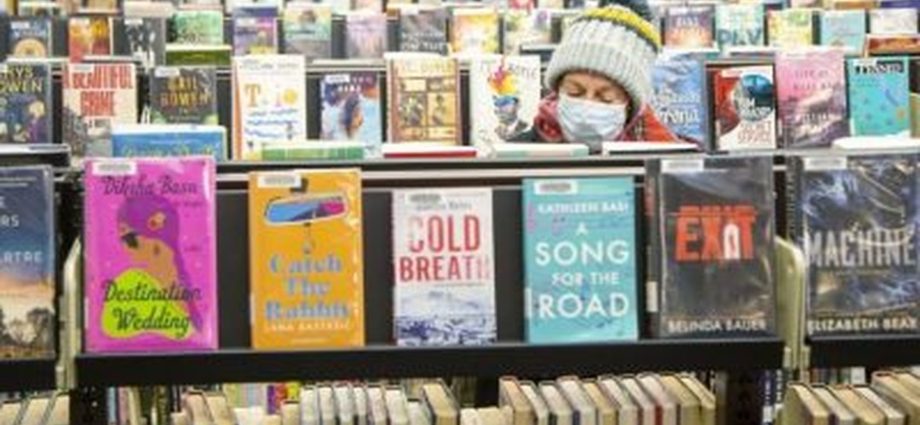
Museums, libraries keep up virtual programs as in-person visits lag
File photo. Calvi Leon, Local Journalism Initiative Reporter
By Calvi Leon, Local Journalism Initiative Reporter, London Free Press
December 09, 2021
Back open for months now, many cultural institutions in Southwestern Ontario — from museums to libraries — are not seeing the crowds they once drew before the pandemic.
But even without visitors, some organizations that switched to online programming during the pandemic are relying on the virtual option to build back the traffic on which they depend.
At the London Public Library, visits to its 16 branches were down by nearly one-third in October, compared to before the pandemic, the latest figures from the library shows. The service reported a total of 78,000 in-person visits that month, down from its 240,000 in 2019.
A large reason for the decline is that social distancing makes it challenging to offer activities, said Ellen Hobin, manager of communications for the library.
“Programs were a big driver for people visiting the library,” she said. “We would (also) let other organizations offer programs in our spaces, or people could rent our spaces to offer programs.”
The library offered 1,300 programs in 2019 but transitioned to outdoor activities, such as story-time for children when the pandemic struck, Hobin said.
Still, that hasn’t stopped patrons from using its services, she said, adding the library offers digital and physical library materials.
Checkouts of materials has remained consistent, with 300,000 in October down 8,000 from 2019. The use of digital materials has increased during the same period, Hobin said.
“The service that’s really grown, not surprisingly, is all of our online books, audiobooks and movies,” she said. “People are pretty excited to find that stuff, although they are still borrowing physical materials, too.”
Museums, art galleries and libraries were some of the last places to receive the green light for reopening to the public. Under Stage 3 of the Reopening Ontario Act, the centres were permitted to run in July at 50 per capacity indoors.
For the London Children’s Museum, July 26 marked the end of a challenging period in which staff were forced to close the building three separate times amid the pandemic.
“Since March 2020, we were ultimately closed for 363 days between that several-month period,” said Mira Noordermeer, the marketing and communications coordinator. “We had three separate closures in that time, so certainly that was challenging.”
Unlike the London Public Library and several other museums across Ontario, the children’s museum requires all staff and visitors to show proof of vaccination.
It’s one of many steps the museum is taking to get families and children back into programming, Noordermeer said.
“We’re just working with visitors to create an environment that they’re comfortable and happy to be in,” she said.
While most of its activities have returned to normal — with between 100 and 150 people coming to the museum each day — many programs, including field trips during March and winter breaks, have been put on pause, Noordermeer said.
At those times, “we might have had 600 (people) throughout the day, which is quite a bit busier. But we won’t be experiencing that kind of traffic anytime soon.”
At Lambton Heritage Museum in Grand Bend, there was a 15 per cent decrease in visits in August and compared to the same month before the pandemic, according to the museum’s latest figures.
Like many other museums, Lambton Heritage relies heavily on in-person programs, such as interacting with artifacts and educational collections people can touch, said Dana Thorne, curator and supervisor for the museum.
“It’s hard to think about how to do that when people can’t touch anything. It’s certainly something we’ve had to struggle with.”
While traditional experiences are no longer the same, online engagement has, in some ways, increased considerably, Thorne said, citing the museum’s virtual lectures.
“We’ve been doing virtual talks on different local history topics, and we might have 100 or 110 people come out and watch … Whereas doing an in-person lecture here at the museum, you might have 15 or 20 people who would physically come to the museum. . . . In that way, it is nice to be able to deliver content virtually and really expand our reach.”
Moving forward, Thorne said the museum might adopt a “hybrid model” in which activities are conducted both online and in-person.
Marie Lalonde, executive director for the Ontario Museum Association, which represents about 700 museums across Ontario, estimates many will continue adopting “new approaches to exhibits, planning visits and learning online.”
“If we can find the resources to support the work, I think some of the virtual opportunities will create greater accessibility, not only locally but to people outside your region and across the world … and some of these practices are here to stay,” Lalonde said.
Subscribe to our newsletter.
“At the same time, it’s recognized there’s nothing that can replace that authentic experience of being next to or in front of a very significant artifact that tells a compelling story.”
The Local Journalism Initiative is funded by the Government of Canada


